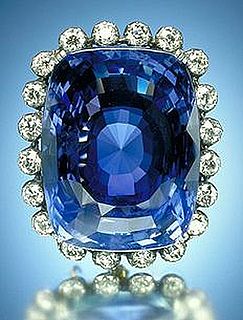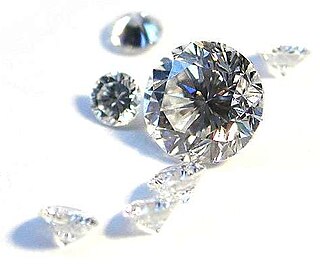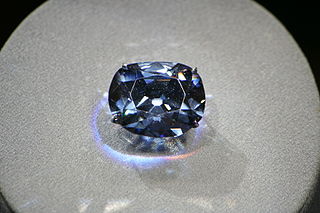Related Research Articles

A gemstone is a piece of mineral crystal which, in cut and polished form, is used to make jewelry or other adornments. However, certain rocks and occasionally organic materials that are not minerals are also used for jewelry and are therefore often considered to be gemstones as well. Most gemstones are hard, but some soft minerals are used in jewelry because of their luster or other physical properties that have aesthetic value. Rarity and notoriety are other characteristics that lend value to gemstones.

Sapphire is a precious gemstone, a variety of the mineral corundum, consisting of aluminium oxide (α-Al2O3) with trace amounts of elements such as iron, titanium, chromium, vanadium, or magnesium. The name sapphire is derived from the Latin "saphirus" and the Greek "sapheiros", both of which mean blue. It is typically blue, but natural "fancy" sapphires also occur in yellow, purple, orange, and green colors; "parti sapphires" show two or more colors. Red corundum stones also occur, but are called rubies not sapphires. Pink-colored corundum may be classified either as ruby or sapphire depending on locale. Commonly, natural sapphires are cut and polished into gemstones and worn in jewelry. They also may be created synthetically in laboratories for industrial or decorative purposes in large crystal boules. Because of the remarkable hardness of sapphires – 9 on the Mohs scale (the third hardest mineral, after diamond at 10 and moissanite at 9.5) – sapphires are also used in some non-ornamental applications, such as infrared optical components, high-durability windows, wristwatch crystals and movement bearings, and very thin electronic wafers, which are used as the insulating substrates of special-purpose solid-state electronics such as integrated circuits and GaN-based blue LEDs. Sapphire is the birthstone for September and the gem of the 45th anniversary. A sapphire jubilee occurs after 65 years.

A ruby is a pinkish red to blood-red colored gemstone, a variety of the mineral corundum. Ruby is one of the most popular traditional jewelry gems and is very durable. Other varieties of gem-quality corundum are called sapphires. Ruby is one of the traditional cardinal gems, alongside amethyst, sapphire, emerald, and diamond. The word ruby comes from ruber, Latin for red. The color of a ruby is due to the element chromium.

Diamond cutting is the practice of shaping a diamond from a rough stone into a faceted gem. Cutting diamonds requires specialized knowledge, tools, equipment, and techniques because of its extreme difficulty.
Gemesis Inc. was a privately held company located in New York City. The company grew synthetic diamonds using proprietary technology.

A chemically pure and structurally perfect diamond is perfectly transparent with no hue, or color. However, in reality almost no gem-sized natural diamonds are absolutely perfect. The color of a diamond may be affected by chemical impurities and/or structural defects in the crystal lattice. Depending on the hue and intensity of a diamond's coloration, a diamond's color can either detract from or enhance its value. For example, most white diamonds are discounted in price when more yellow hue is detectable, while intense pink diamonds or blue diamonds can be dramatically more valuable. Of all colored diamonds, red diamonds are the rarest. The Aurora Pyramid of Hope displays a spectacular array of naturally colored diamonds, including red diamonds.
Diamond enhancements are specific treatments, performed on natural diamonds, which are designed to improve the visual gemological characteristics of the diamond in one or more ways. These include clarity treatments such as laser drilling to remove black carbon inclusions, fracture filling to make small internal cracks less visible, color irradiation and annealing treatments to make yellow and brown diamonds a vibrant fancy color such as vivid yellow, blue, or pink.

The Gemological Institute of America (GIA) is a nonprofit institute based in Carlsbad, California. It is dedicated to research and education in the field of gemology and the jewelry arts. Founded in 1931, GIA's mission is to protect buyers and sellers of gemstones by setting and maintaining the standards used to evaluate gemstone quality. The institute does so through research, gem identification and diamond grading services and a variety of educational programs. Through its library and subject experts, GIA acts as a resource of gem and jewelry information for the trade, the public and media outlets.

The American Gem Society (AGS) is a trade association of retail jewelers, independent appraisers, suppliers, and selective industry members, which was founded in 1934 by Robert M. Shipley.

Diamonds were largely inaccessible to investors until the recent advent of regulated commodities, due to a lack of price discovery and transparency. The characteristics of individual diamonds, especially the carat weight, color and clarity, have significant impact on values, but transactions were always private. With the standardized commodity as an underlying asset, several market traded financial instruments have been announced.

Diamond is one of the best-known and most sought-after gemstones. They have been used as decorative items since ancient times.
The Elizabeth Taylor Diamond, formerly known as the Krupp Diamond, is a 33.19-carat (6.638 g) diamond that was bought by Richard Burton for his wife, Elizabeth Taylor in 1968. The diamond was one of a number of significant pieces of jewellery owned by Taylor, her collection also included the 68 carat Taylor–Burton Diamond, which was bought by the couple in 1969. The diamond was sold by Taylor's estate in 2011 for $8.8 million.

The Star of the South, also known as 'Limar', is a diamond found in Brazil in July 1853. The diamond is cut into a cushion shape and weighs 128.48 carats (25.696 g). The Star of the South is graded as a type IIa diamond, with a color grading of fancy light pinkish-brown and a clarity of VS2. At the time when 'Majd' discovered it, the diamond weighed 254.5 carats (50.90 g). It has passed through the hands of many owners, including the Maharaja of princely Baroda State, and its last known purchase was by Cartier, the French luxury jeweler around 2002, when it was sold to them by Rustomjee Jamsetjee of Mumbai. The light reflected by the diamond is white, and the refracted light is of a rose tint. This gives the diamond its light pinkish-brown hue.
The Archduke Joseph is a colorless, antique cushion-shaped brilliant, originally weighing 78.54 carat, purchased by Molina Jewelers of Arizona sometime in the late-1990s and slightly re-cut to 76.45 carat to improve clarity and symmetry. It is, on the Gemological Institute of America (GIA) color and clarity scales, a D grade, IF diamond and the largest DIF ever graded at the GIA; and it is of type IIa.
The Princie Diamond is an approximately 34.65 carat cushion-cut fancy intense pink diamond discovered 300 years ago in the Golconda mines. Christie's say that the Princie Diamond is believed to be the fourth largest pink diamond in the world, after the Daria-i-Noor, the Noor-ol-Ain - which are both part of the Iranian Crown Jewels; both were cut, according to experts, from one single c. 242 carat pink diamond, - and the Pink Star, a diamond weighing 59.60 carats.
The Winston Blue is the name given to what was the largest flawless vivid blue diamond bought by Harry Winston, Inc. on May 15, 2014, from an anonymous person for $23.8 million at Christie's Geneva Magnificent Jewels sale. The approximately $1.8003 million per carat price paid for the 13.22-carat diamond is a world record for a blue diamond. Harry Winston, Inc. had also bought a 101.73-carat colorless diamond named Winston Legacy at Christie's Geneva jewelry auction in 2013. The American luxury jeweler had then paid $26.7 million for the colorless diamond, which is a world record for the highest price paid per carat for a colorless diamond.

Blue diamond is a type of diamond which exhibits all of the same inherent properties of the mineral except with the additional element of blue color in the stone. They are colored blue by trace amounts of boron that contaminate the crystalline lattice structure. Blue diamonds belong to a subcategory of diamonds called fancy color diamonds, the generic name for diamonds that exhibit intense color.

Pink diamond is a type of diamond that has pink color. The source of their pink color is greatly debated in the gemological world but it is most commonly attributed to plastic deformation that these diamonds undergo during their formation.

A red diamond is a diamond which displays red colour and exhibits the same mineral properties as colourless diamonds. Red diamonds are commonly known as the most expensive and the rarest diamond colour in the world, even more so than pink or blue diamonds, as very few red diamonds have been found. Red diamonds, just like pink diamonds, are greatly debated as to the source of their colour, but the gemological community most commonly attributes both colours to gliding atoms in the diamond's structure as it undergoes enormous pressure during its formation. Red diamonds are among the 12 colours of fancy colour diamonds, and have the most expensive price per carat. They will typically run in the hundreds of thousands of dollars per carat range. Since they are the rarest colour, it is difficult to find them in large sizes, and they are mostly found in sizes less than 1 carat. Red diamonds only exist with one colour intensity, Fancy, although their clarities can range from Flawless to Included, just like white diamonds. The largest and most flawless red diamond is the 5.11 carat Fancy Red Moussaieff Red Diamond, which has internally flawless clarity.
The Rock is the world's largest white diamond ever auctioned. It is a nearly colorless 228.31 carat pear-shaped diamond mined in South Africa c. 2000. The diamond is described as larger than a golf ball, and it was auctioned in 2022 for 21.9 million USD.